Teaching reading communicatively Types of reading
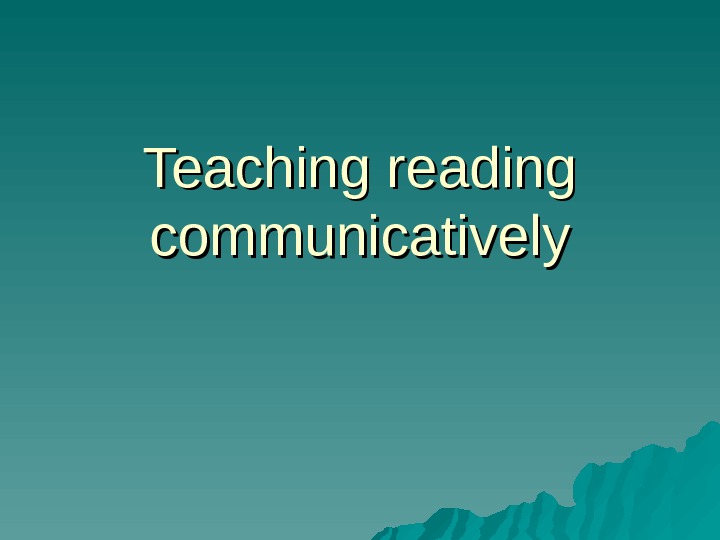
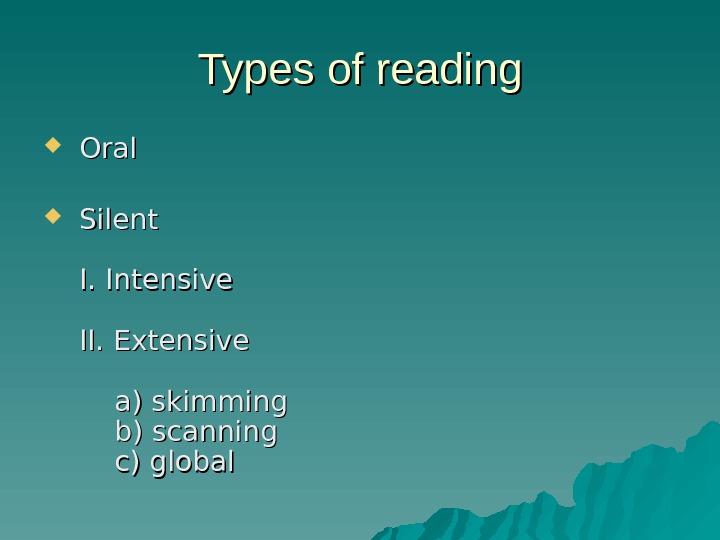
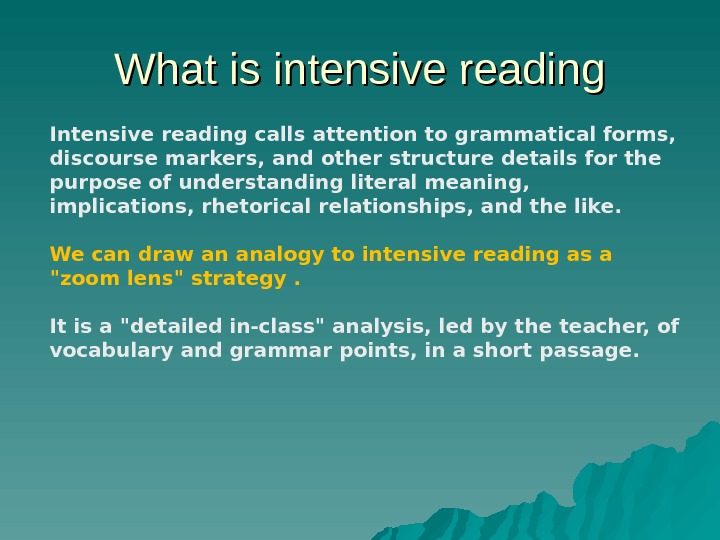
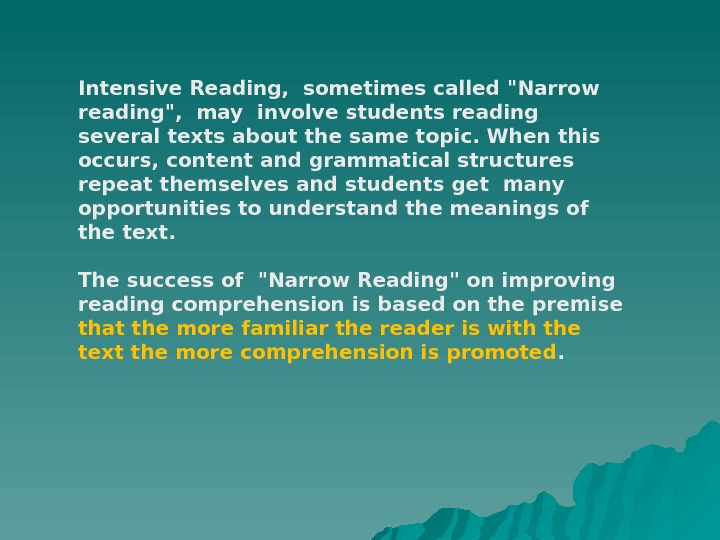
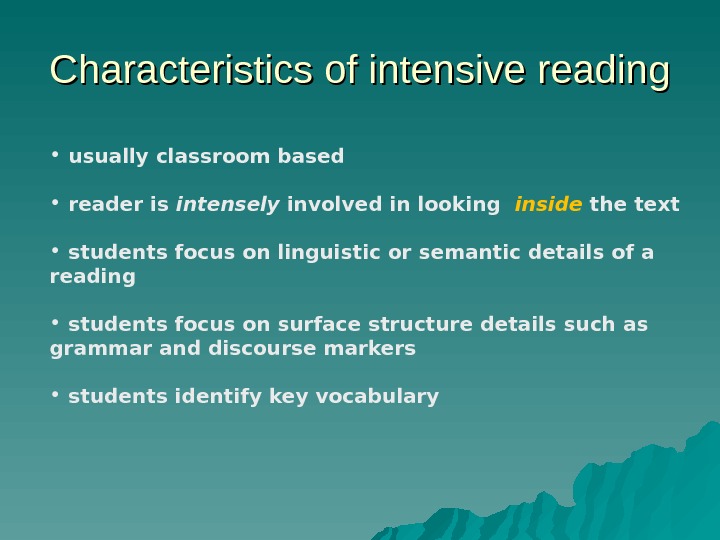
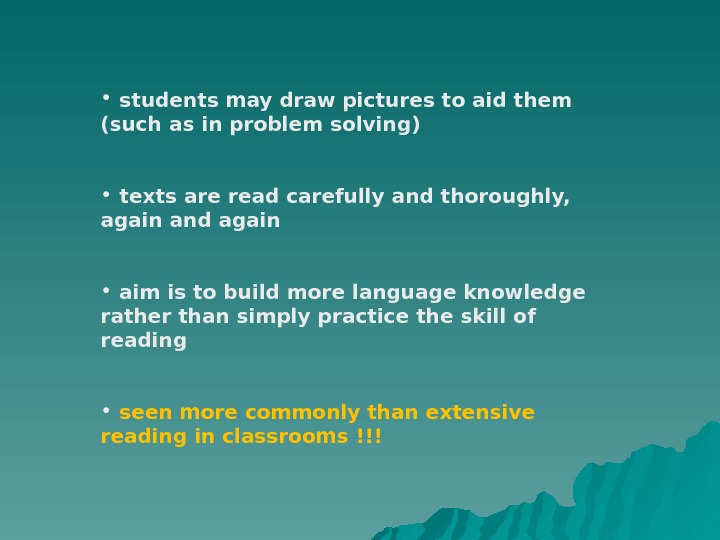
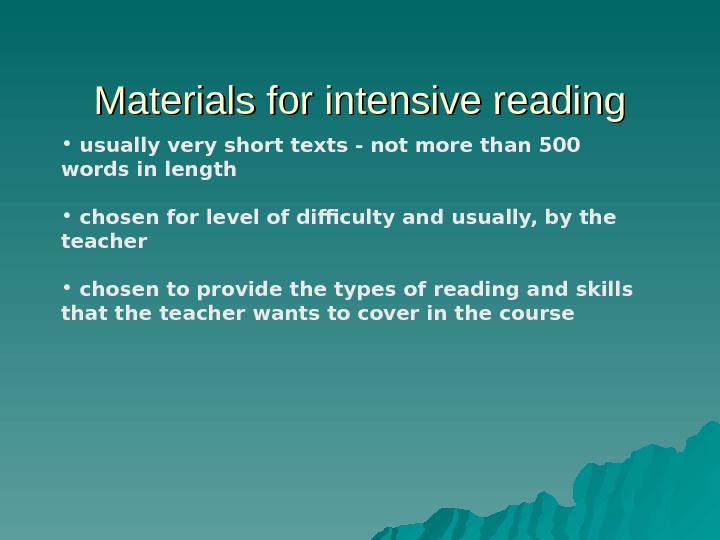

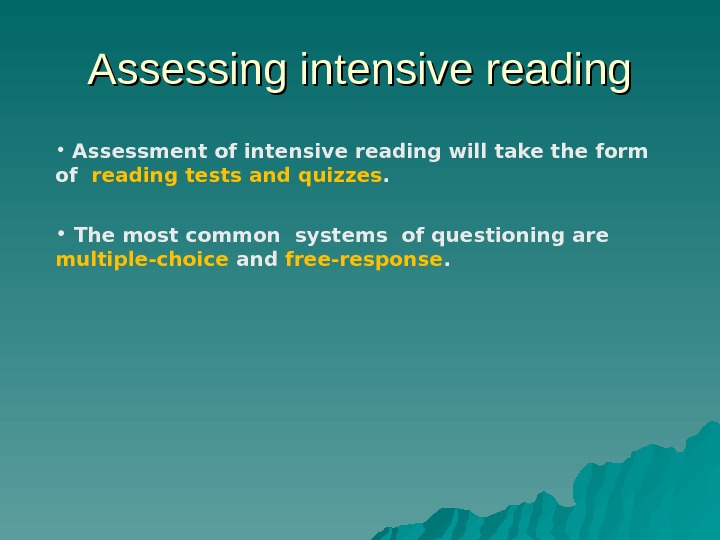
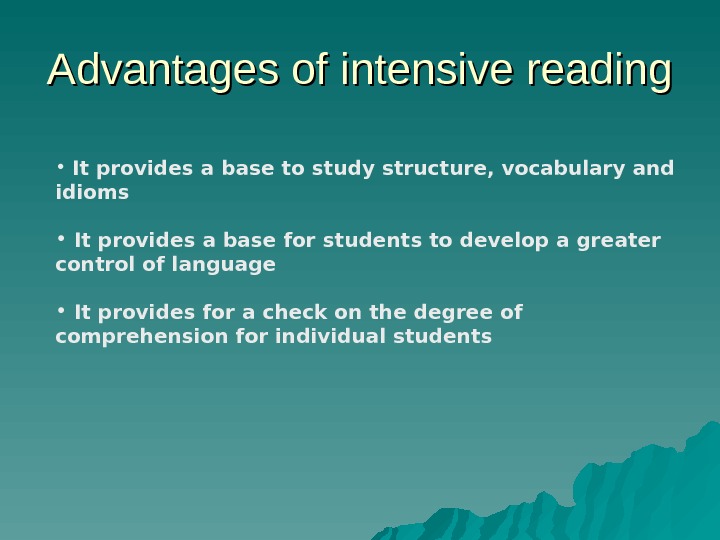
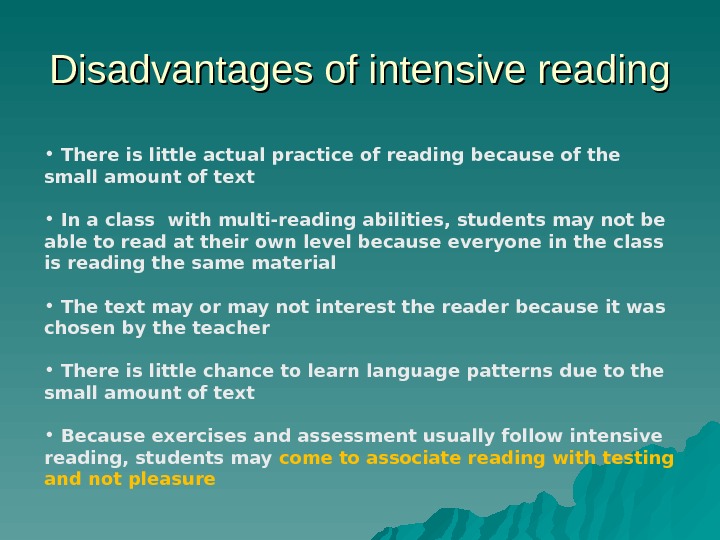
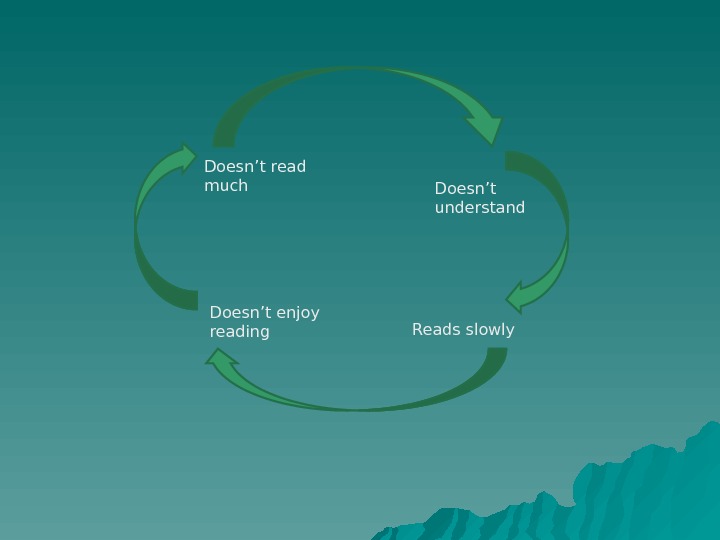
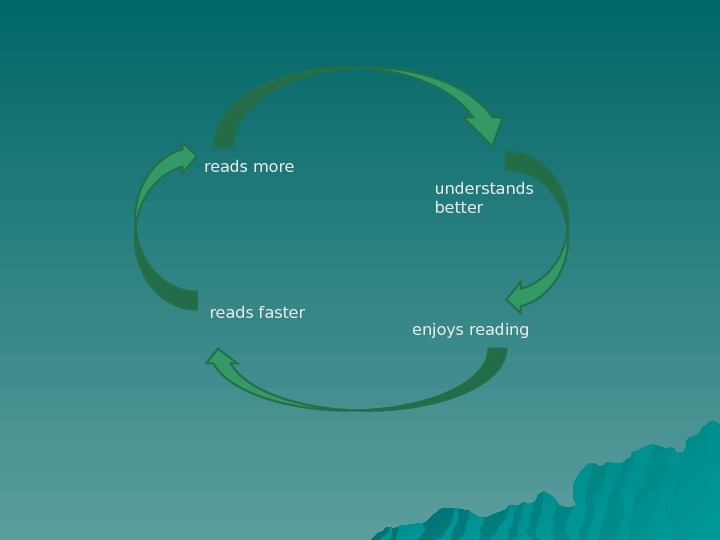
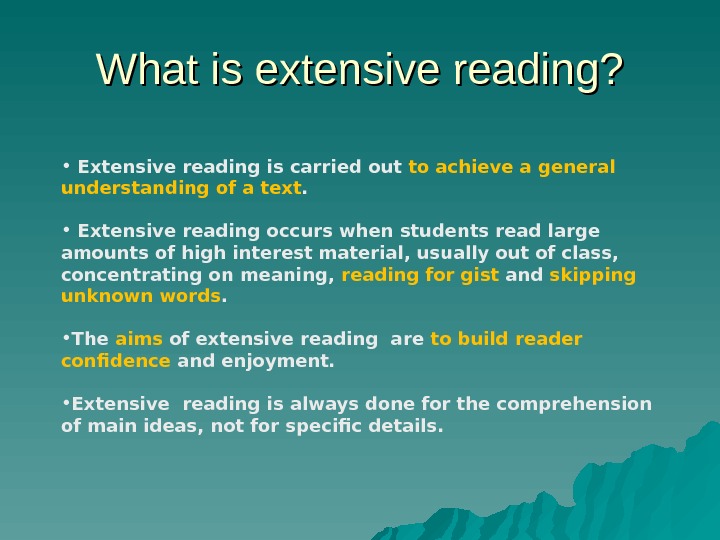
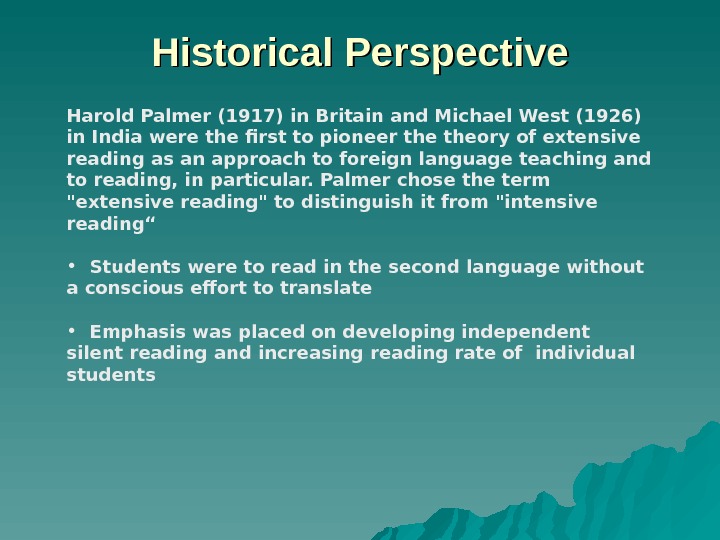

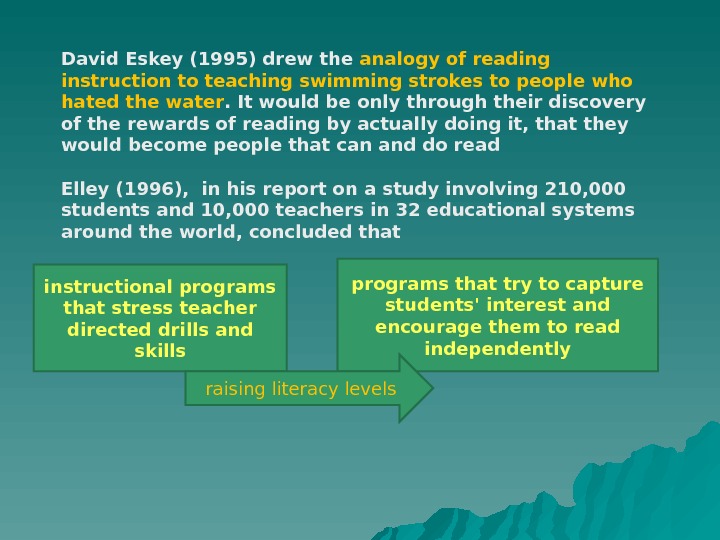
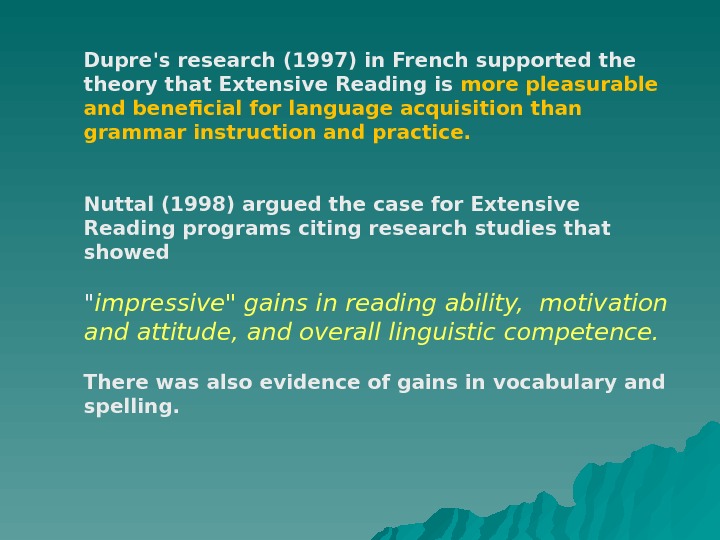
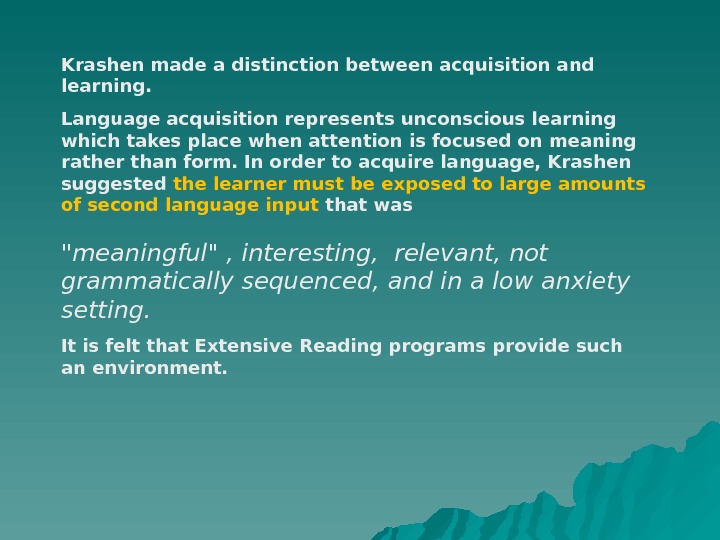
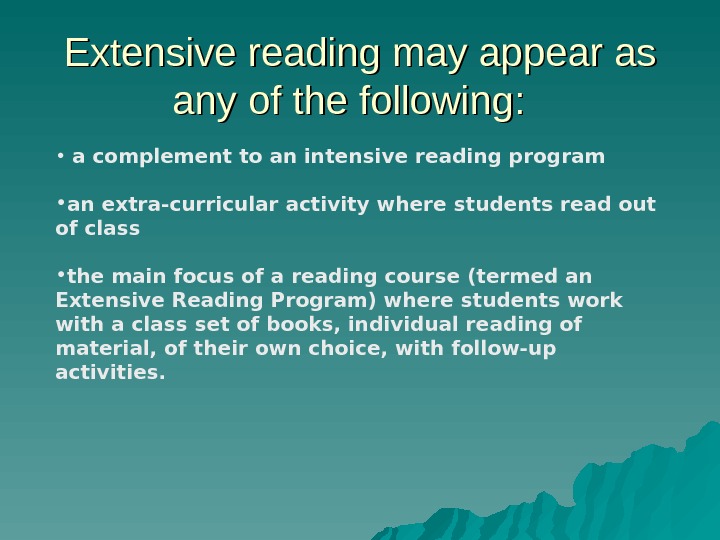
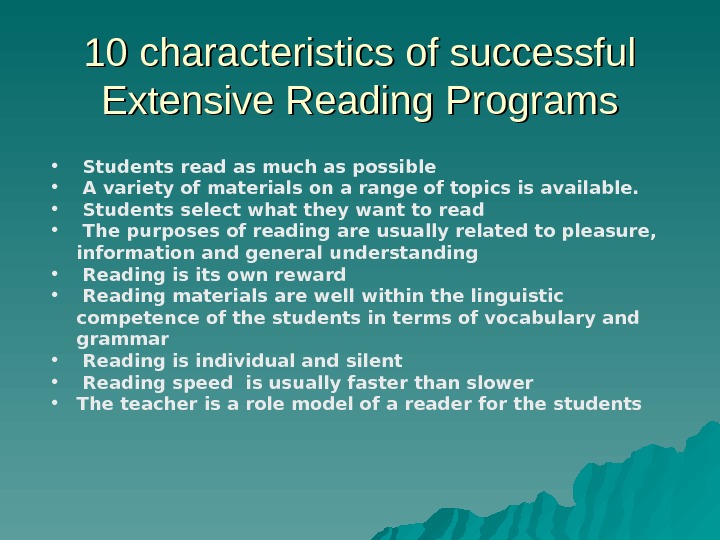
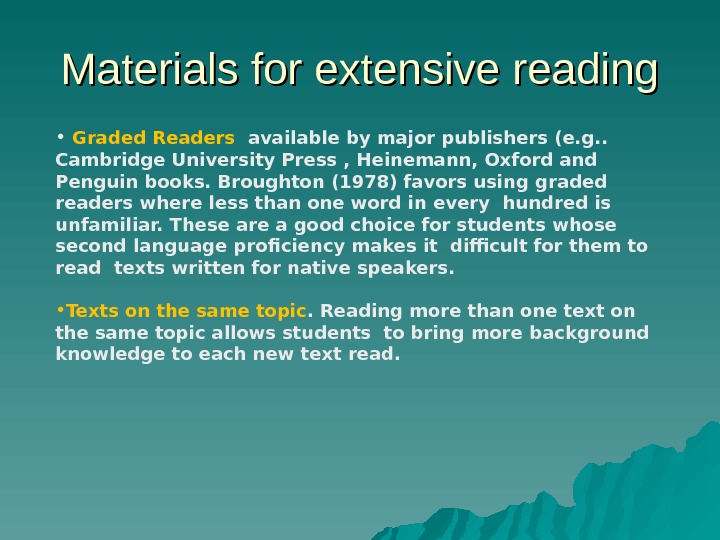
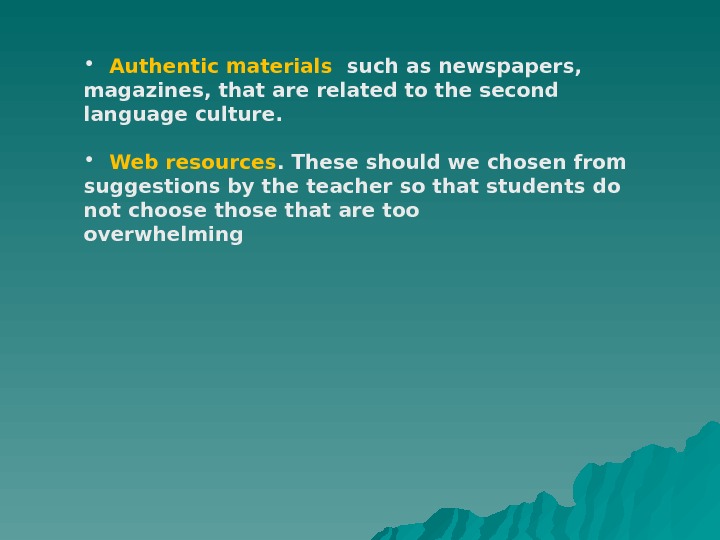
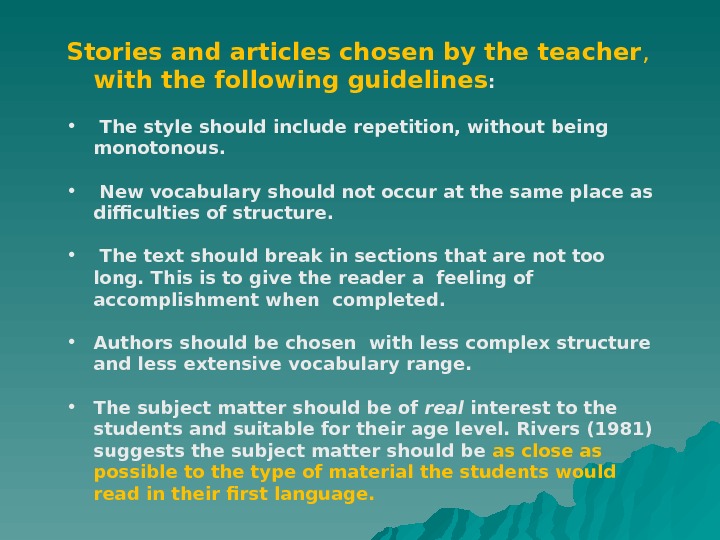
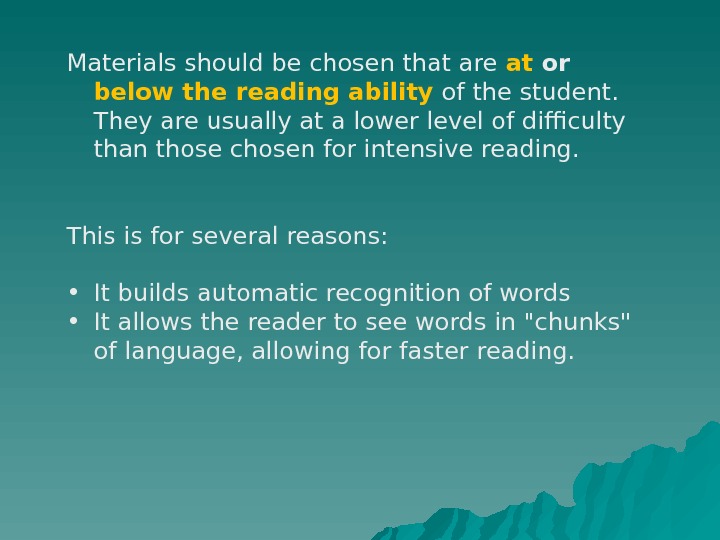
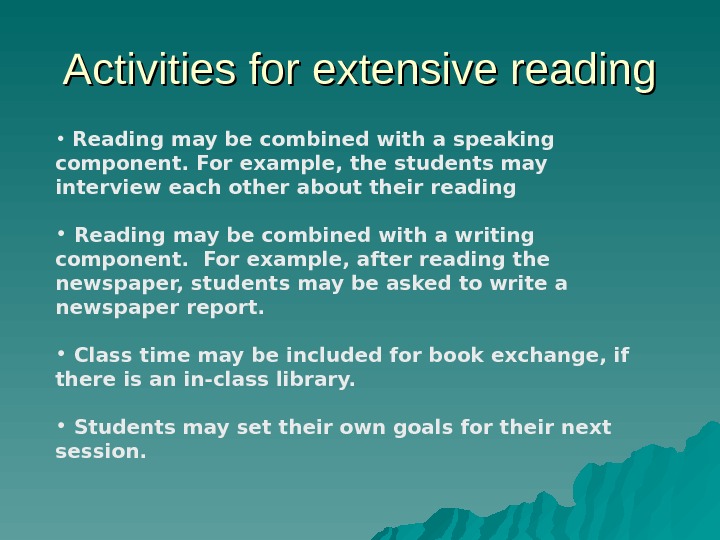
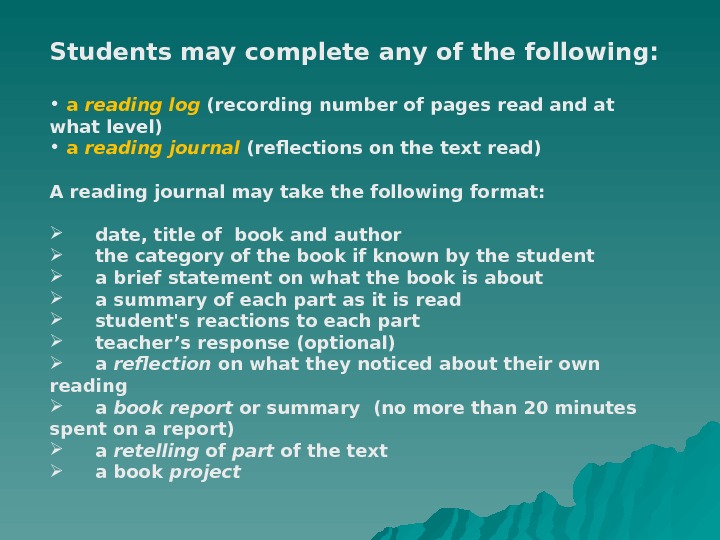
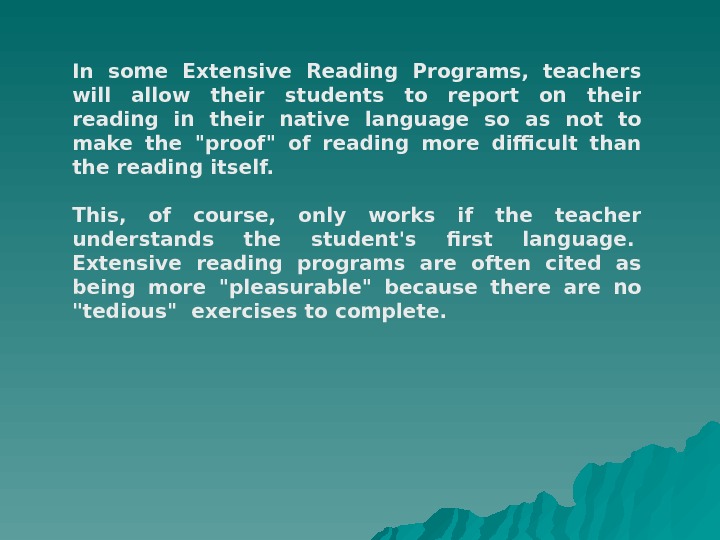
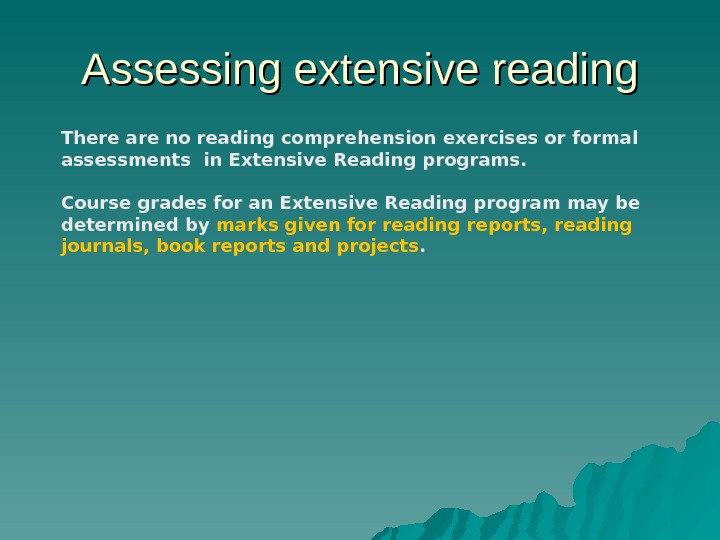
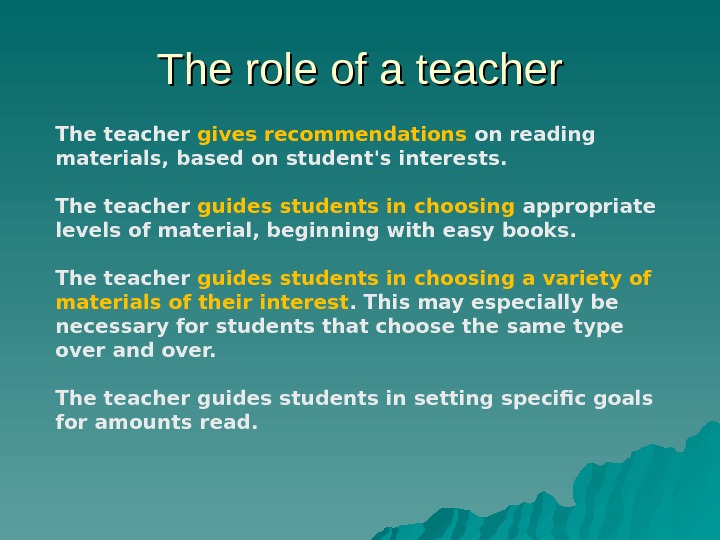
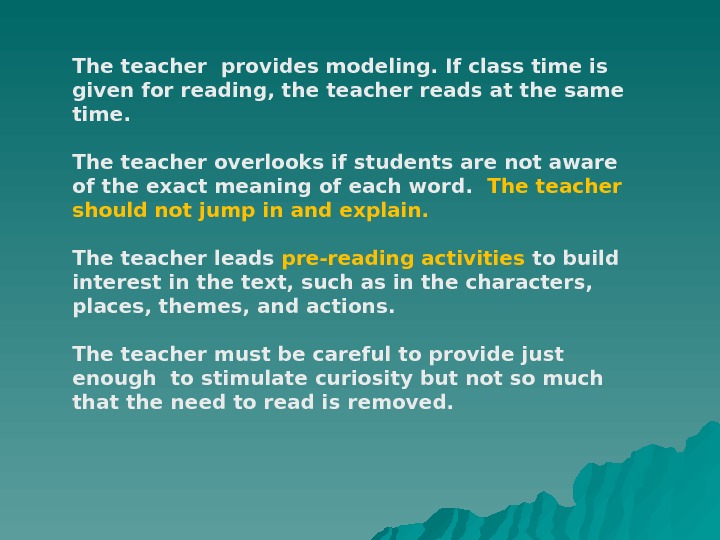
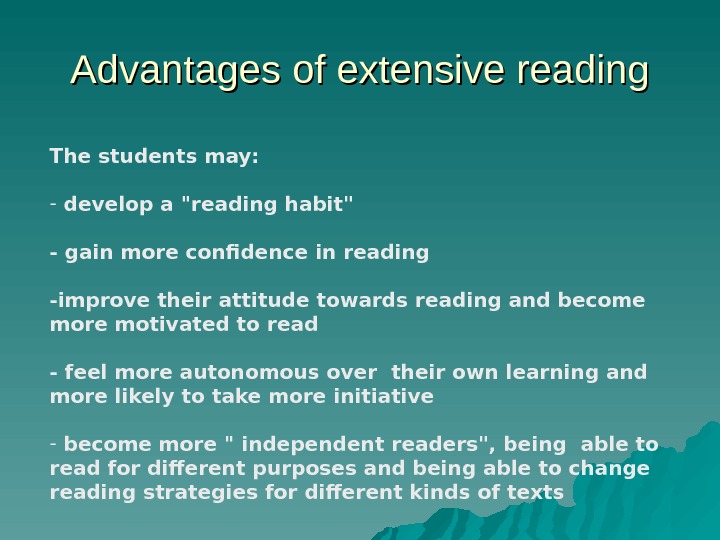
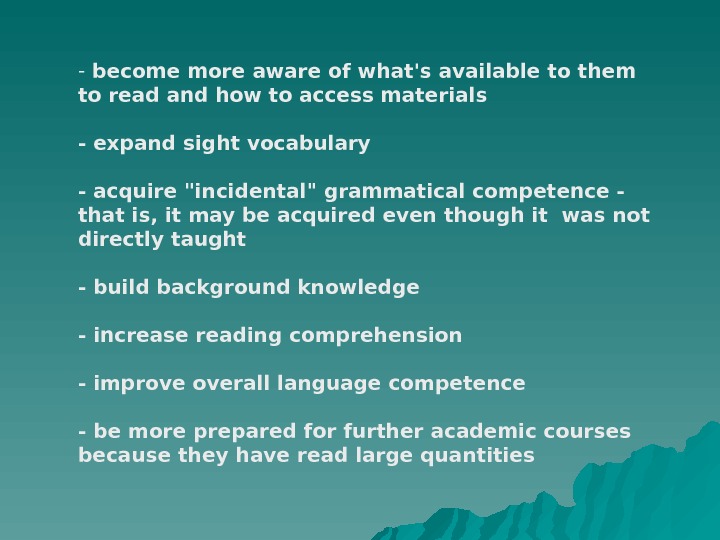
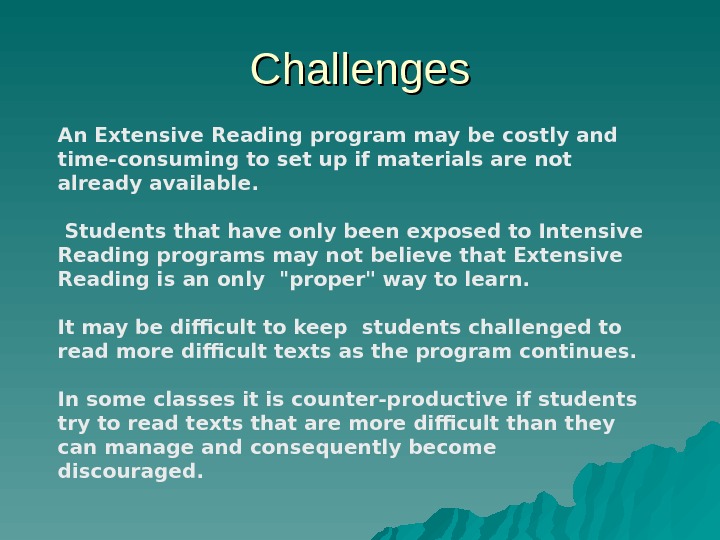
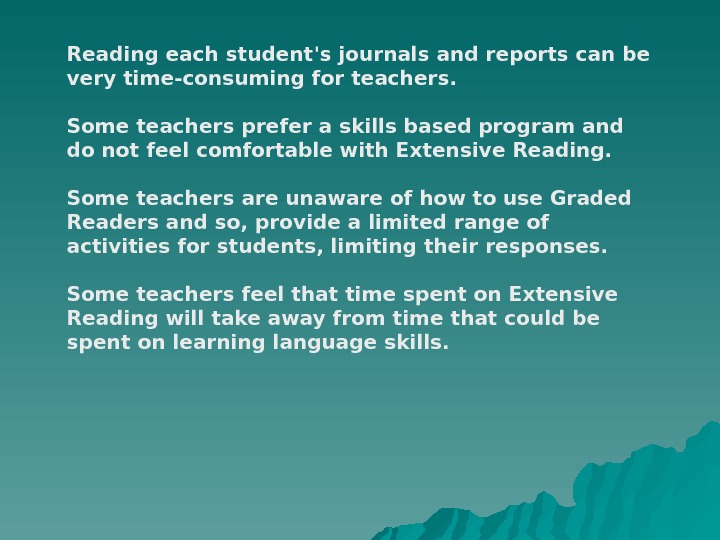
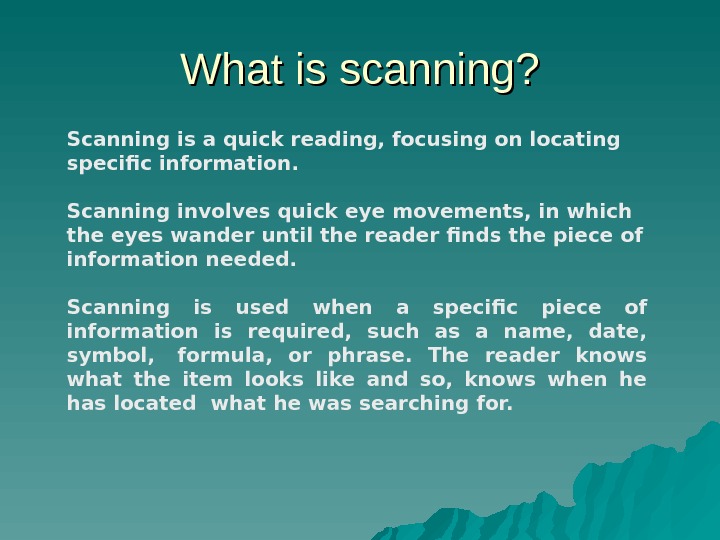
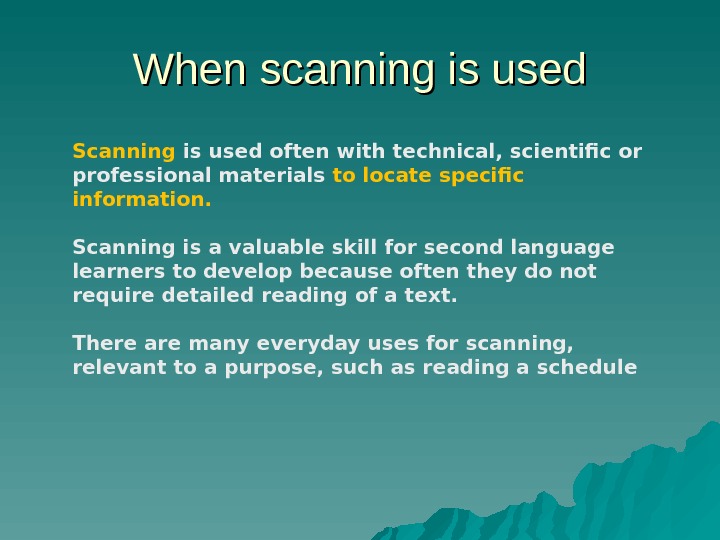
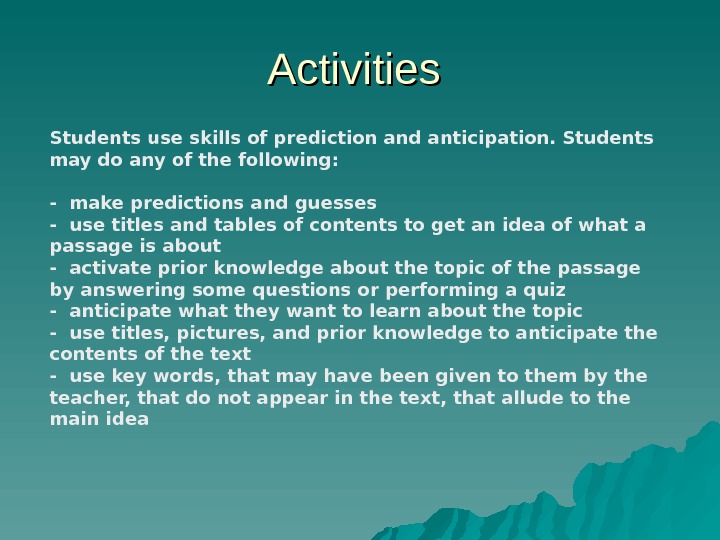

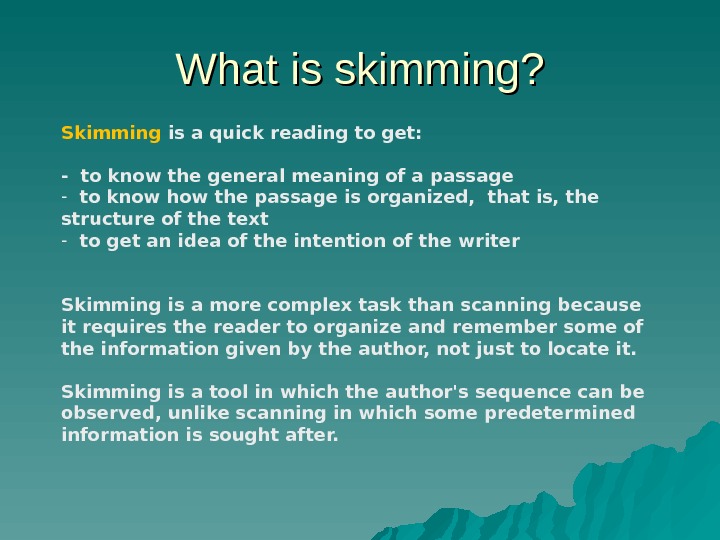
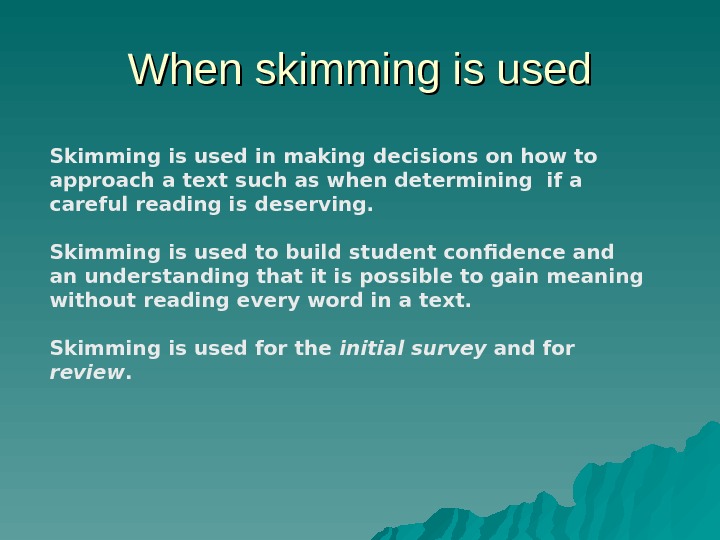
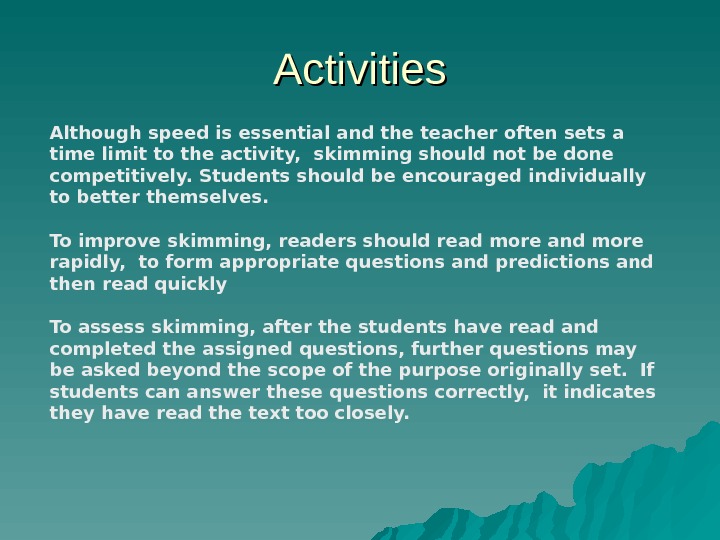
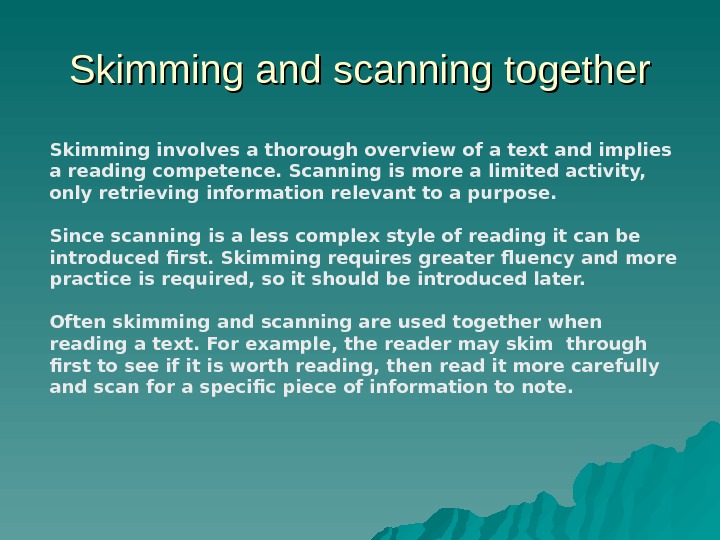
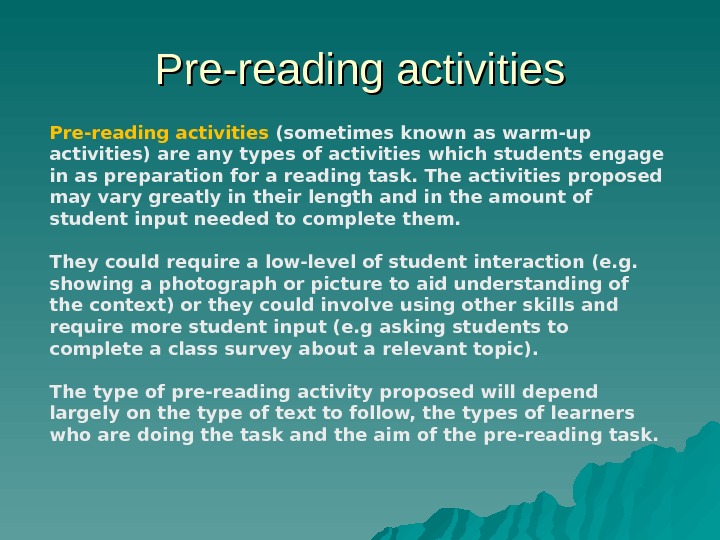
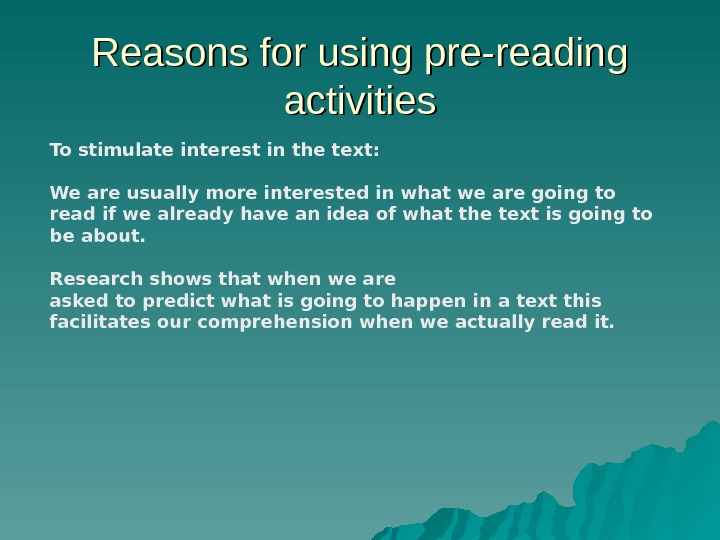
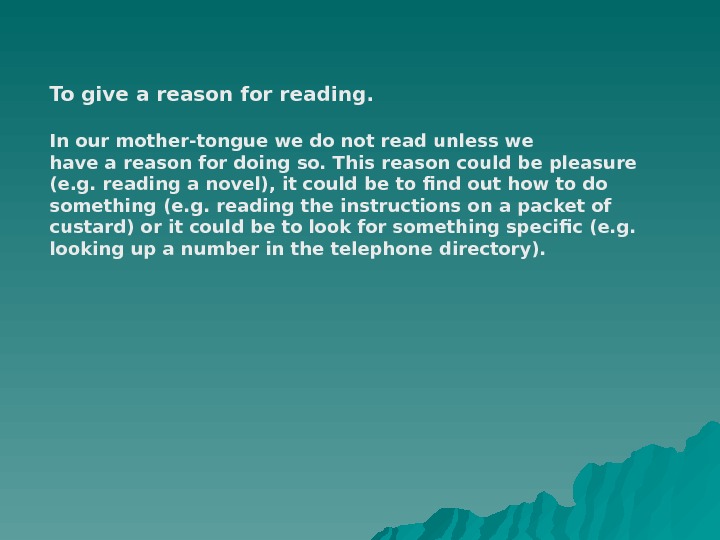
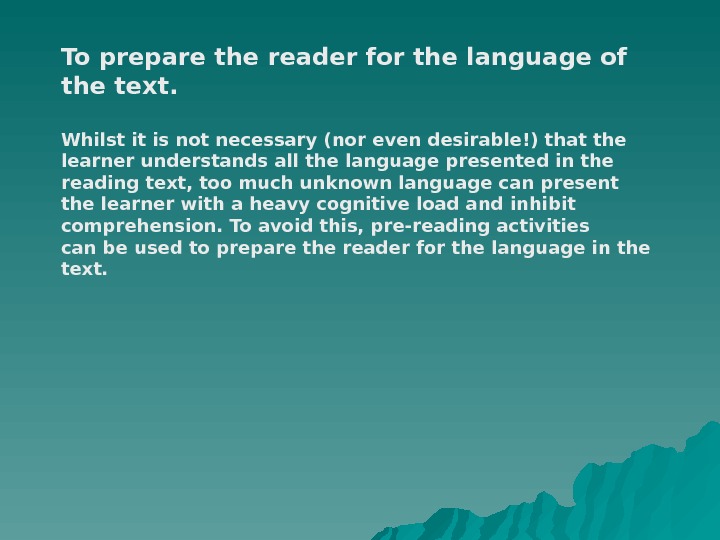
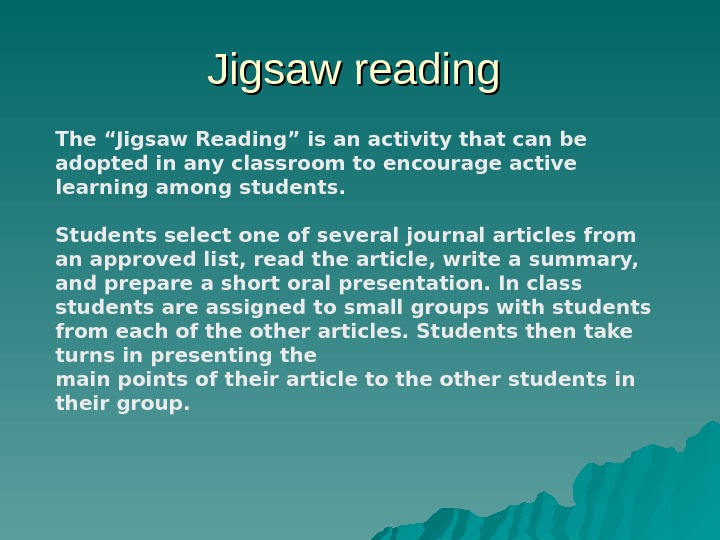
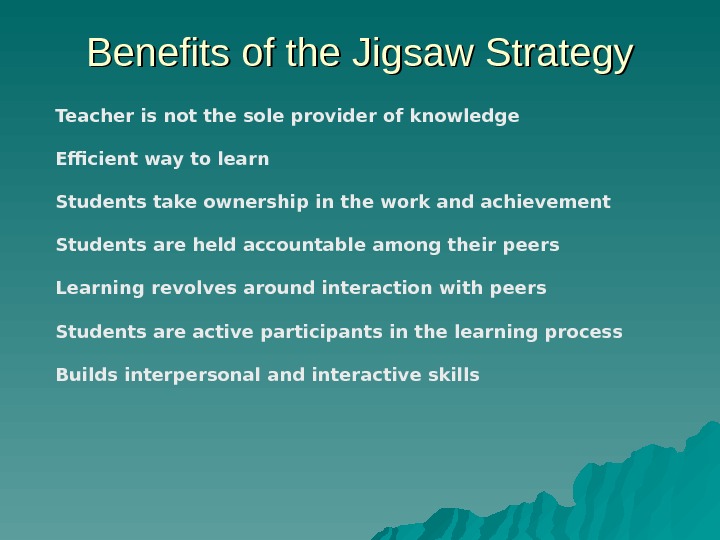
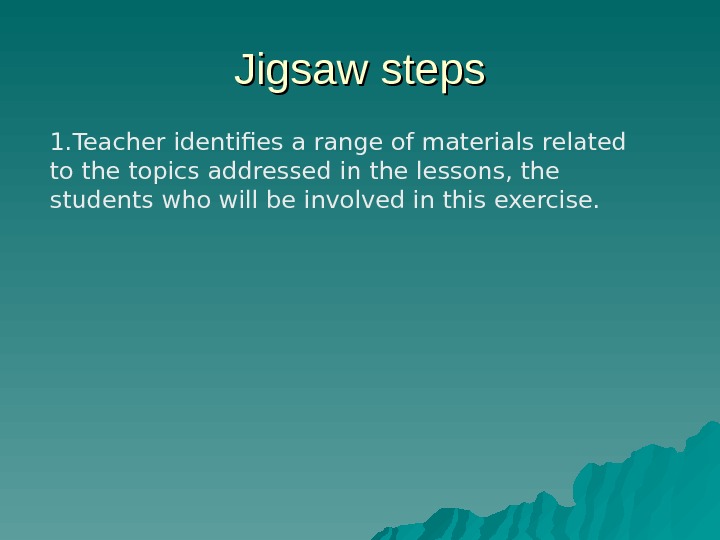
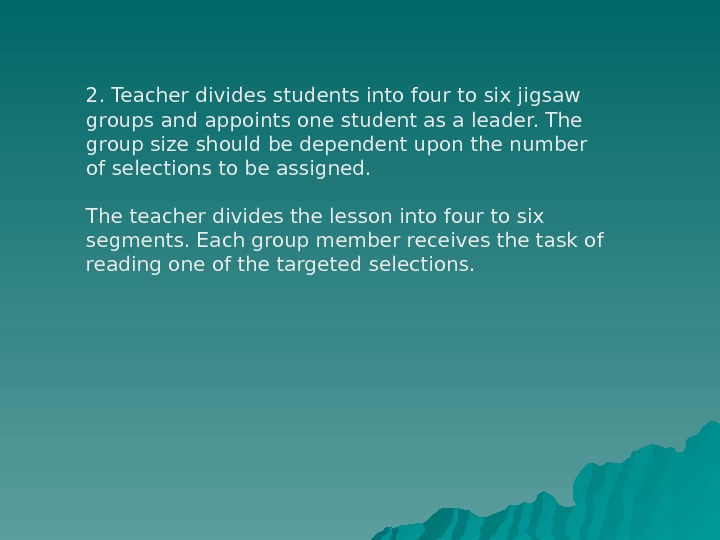
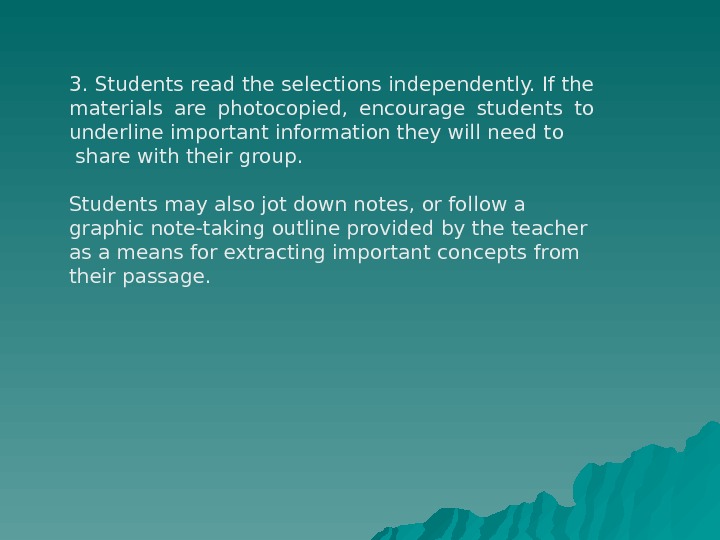

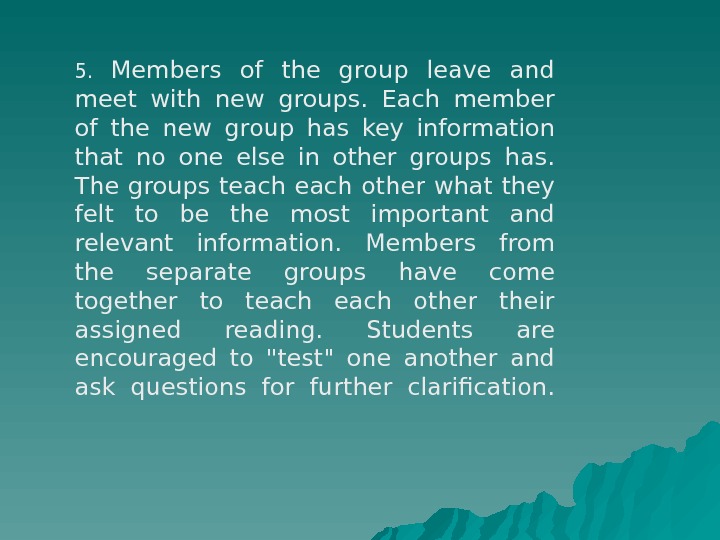
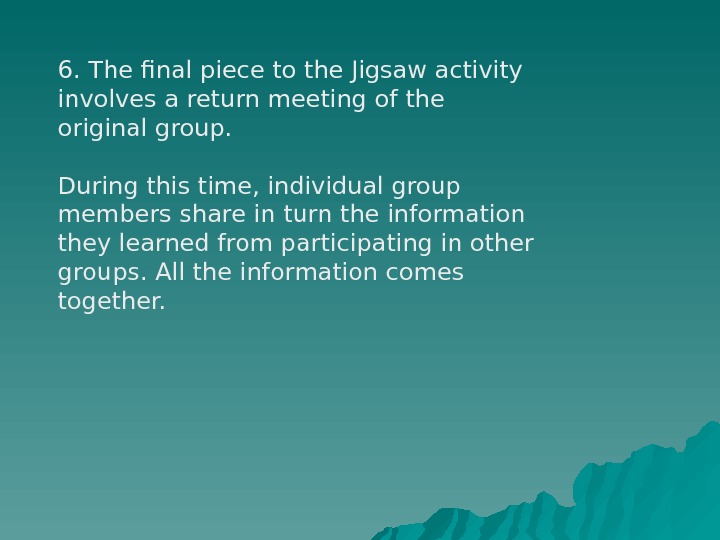
teaching_reading_communicatively.ppt
- Размер: 390 Кб
- Количество слайдов: 55
Описание презентации Teaching reading communicatively Types of reading по слайдам
 Teaching reading communicatively
Teaching reading communicatively
 Types of reading Oral Silent I. Intensive II. Extensive a) skimming b) scanning c) global
Types of reading Oral Silent I. Intensive II. Extensive a) skimming b) scanning c) global
 What is intensive reading Intensive reading calls attention to grammatical forms, discourse markers, and other structure details for the purpose of understanding literal meaning, implications, rhetorical relationships, and the like. We can draw an analogy to intensive reading as a «zoom lens» strategy. It is a «detailed in-class» analysis, led by the teacher, of vocabulary and grammar points, in a short passage.
What is intensive reading Intensive reading calls attention to grammatical forms, discourse markers, and other structure details for the purpose of understanding literal meaning, implications, rhetorical relationships, and the like. We can draw an analogy to intensive reading as a «zoom lens» strategy. It is a «detailed in-class» analysis, led by the teacher, of vocabulary and grammar points, in a short passage.
 Intensive Reading, sometimes called «Narrow reading», may involve students reading several texts about the same topic. When this occurs, content and grammatical structures repeat themselves and students get many opportunities to understand the meanings of the text. The success of «Narrow Reading» on improving reading comprehension is based on the premise that the more familiar the reader is with the text the more comprehension is promoted.
Intensive Reading, sometimes called «Narrow reading», may involve students reading several texts about the same topic. When this occurs, content and grammatical structures repeat themselves and students get many opportunities to understand the meanings of the text. The success of «Narrow Reading» on improving reading comprehension is based on the premise that the more familiar the reader is with the text the more comprehension is promoted.
 Characteristics of intensive reading • usually classroom based • reader is intensely involved in looking inside the text • students focus on linguistic or semantic details of a reading • students focus on surface structure details such as grammar and discourse markers • students identify key vocabulary
Characteristics of intensive reading • usually classroom based • reader is intensely involved in looking inside the text • students focus on linguistic or semantic details of a reading • students focus on surface structure details such as grammar and discourse markers • students identify key vocabulary
 • students may draw pictures to aid them (such as in problem solving) • texts are read carefully and thoroughly, again and again • aim is to build more language knowledge rather than simply practice the skill of reading • seen more commonly than extensive reading in classrooms !!!
• students may draw pictures to aid them (such as in problem solving) • texts are read carefully and thoroughly, again and again • aim is to build more language knowledge rather than simply practice the skill of reading • seen more commonly than extensive reading in classrooms !!!
 Materials for intensive reading • usually very short texts — not more than 500 words in length • chosen for level of difficulty and usually, by the teacher • chosen to provide the types of reading and skills that the teacher wants to cover in the course
Materials for intensive reading • usually very short texts — not more than 500 words in length • chosen for level of difficulty and usually, by the teacher • chosen to provide the types of reading and skills that the teacher wants to cover in the course
 Activities during intensive reading or following it • looking at main ideas versus details • understanding what is implied versus stated • making inferences • looking at the order of information and how it effects the message • identifying words thatconnect one idea to another • identifying words that indicate change from one section to another
Activities during intensive reading or following it • looking at main ideas versus details • understanding what is implied versus stated • making inferences • looking at the order of information and how it effects the message • identifying words thatconnect one idea to another • identifying words that indicate change from one section to another
 Assessing intensive reading • Assessment of intensive readingwill take the form of reading tests and quizzes. • The most common systems of questioning are multiple-choice and free-response.
Assessing intensive reading • Assessment of intensive readingwill take the form of reading tests and quizzes. • The most common systems of questioning are multiple-choice and free-response.
 Advantages of intensive reading • It provides a base to study structure, vocabulary and idioms • It provides a base for students to develop a greater control of language • It provides for a check on the degree of comprehension for individual students
Advantages of intensive reading • It provides a base to study structure, vocabulary and idioms • It provides a base for students to develop a greater control of language • It provides for a check on the degree of comprehension for individual students
 Disadvantages of intensive reading • There is little actual practice of reading because of the small amount of text • In a class with multi-reading abilities, students may not be able to read at their own level because everyone in the class is reading the same material • The text may or may not interest the reader because it was chosen by the teacher • There is little chance to learn language patterns due to the small amount of text • Because exercises and assessment usually follow intensive reading, students may come to associate reading with testing and not pleasure
Disadvantages of intensive reading • There is little actual practice of reading because of the small amount of text • In a class with multi-reading abilities, students may not be able to read at their own level because everyone in the class is reading the same material • The text may or may not interest the reader because it was chosen by the teacher • There is little chance to learn language patterns due to the small amount of text • Because exercises and assessment usually follow intensive reading, students may come to associate reading with testing and not pleasure
 Doesn’t understand Reads slowly. Doesn’t read much Doesn’t enjoy reading
Doesn’t understand Reads slowly. Doesn’t read much Doesn’t enjoy reading
 understands better enjoys reading reads more reads faster
understands better enjoys reading reads more reads faster
 What is extensive reading? • Extensive reading is carried out to achieve a general understanding of a text. • Extensive reading occurs when students read large amounts of high interest material, usually out of class, concentrating on meaning, reading for gist and skipping unknown words. • The aims of extensive reading are to build reader confidence and enjoyment. • Extensive reading is always done for the comprehension of main ideas, not for specific details.
What is extensive reading? • Extensive reading is carried out to achieve a general understanding of a text. • Extensive reading occurs when students read large amounts of high interest material, usually out of class, concentrating on meaning, reading for gist and skipping unknown words. • The aims of extensive reading are to build reader confidence and enjoyment. • Extensive reading is always done for the comprehension of main ideas, not for specific details.
 Historical Perspective Harold Palmer (1917) in Britain and Michael West (1926) in India were the first to pioneer theory of extensive reading as an approach to foreign language teaching and to reading, in particular. Palmer chose the term «extensive reading» to distinguish it from «intensive reading“ • Students were to read in the second language without a conscious effort to translate • Emphasis was placed on developing independent silent reading andincreasing reading rate of individual students
Historical Perspective Harold Palmer (1917) in Britain and Michael West (1926) in India were the first to pioneer theory of extensive reading as an approach to foreign language teaching and to reading, in particular. Palmer chose the term «extensive reading» to distinguish it from «intensive reading“ • Students were to read in the second language without a conscious effort to translate • Emphasis was placed on developing independent silent reading andincreasing reading rate of individual students
 Nuttall (1982) wrote that the idea of Extensive Reading should be «standard practice» in second language learning. She suggested the following «slogan»: «The best way to improve your knowledge of a foreign language is to go and live among the speakers. The next best way is to read extensively. » Krashen (1984) supported Extensive Reading because he felt it automatically gave rise to competence in writing. Krashen (1995) argued that extensive reading could be used as a «bridge» from communicative language competence to academic language competence.
Nuttall (1982) wrote that the idea of Extensive Reading should be «standard practice» in second language learning. She suggested the following «slogan»: «The best way to improve your knowledge of a foreign language is to go and live among the speakers. The next best way is to read extensively. » Krashen (1984) supported Extensive Reading because he felt it automatically gave rise to competence in writing. Krashen (1995) argued that extensive reading could be used as a «bridge» from communicative language competence to academic language competence.
 David Eskey (1995) drew the analogy of reading instruction to teaching swimming strokes to people who hated the water. It would be only through their discovery of the rewards of reading by actually doing it, that they would become people that can and do read Elley (1996), in his report on a study involving 210, 000 students and 10, 000 teachers in 32 educational systems around the world, concluded that instructional programs that stress teacher directed drills and skills programs that try to capture students’ interest and encourage them to read independently raising literacy levels
David Eskey (1995) drew the analogy of reading instruction to teaching swimming strokes to people who hated the water. It would be only through their discovery of the rewards of reading by actually doing it, that they would become people that can and do read Elley (1996), in his report on a study involving 210, 000 students and 10, 000 teachers in 32 educational systems around the world, concluded that instructional programs that stress teacher directed drills and skills programs that try to capture students’ interest and encourage them to read independently raising literacy levels
 Dupre’s research (1997) in French supported theory that Extensive Reading is more pleasurable and beneficial for language acquisition than grammar instruction and practice. Nuttal (1998) argued the case for Extensive Reading programs citing research studies that showed » impressive» gains in reading ability, motivation and attitude, and overall linguistic competence. There was also evidence of gains in vocabulary and spelling.
Dupre’s research (1997) in French supported theory that Extensive Reading is more pleasurable and beneficial for language acquisition than grammar instruction and practice. Nuttal (1998) argued the case for Extensive Reading programs citing research studies that showed » impressive» gains in reading ability, motivation and attitude, and overall linguistic competence. There was also evidence of gains in vocabulary and spelling.
 Krashen made a distinction between acquisition and learning. Language acquisition represents unconscious learning which takes place when attention is focused on meaning rather than form. In order to acquire language, Krashen suggested the learner must be exposed to large amounts of second language input that was «meaningful» , interesting, relevant, not grammatically sequenced, and in a low anxiety setting. It is felt that Extensive Reading programs provide such an environment.
Krashen made a distinction between acquisition and learning. Language acquisition represents unconscious learning which takes place when attention is focused on meaning rather than form. In order to acquire language, Krashen suggested the learner must be exposed to large amounts of second language input that was «meaningful» , interesting, relevant, not grammatically sequenced, and in a low anxiety setting. It is felt that Extensive Reading programs provide such an environment.
 Extensive reading may appear as any of the following: • a complement to an intensive reading program • an extra-curricular activity where students read out of class • the main focus of a reading course (termed an Extensive Reading Program) where students work with a class set of books, individual reading of material, of their own choice, with follow-up activities.
Extensive reading may appear as any of the following: • a complement to an intensive reading program • an extra-curricular activity where students read out of class • the main focus of a reading course (termed an Extensive Reading Program) where students work with a class set of books, individual reading of material, of their own choice, with follow-up activities.
 10 characteristics of successful Extensive Reading Programs • Students read as much as possible • A variety of materials on a range of topics is available. • Students select what they want to read • The purposes of reading are usually related to pleasure, information and general understanding • Reading is its own reward • Reading materials are well within the linguistic competence of the students in terms of vocabulary and grammar • Reading is individual and silent • Reading speed is usually faster than slower • The teacher is a role model of a reader for the students
10 characteristics of successful Extensive Reading Programs • Students read as much as possible • A variety of materials on a range of topics is available. • Students select what they want to read • The purposes of reading are usually related to pleasure, information and general understanding • Reading is its own reward • Reading materials are well within the linguistic competence of the students in terms of vocabulary and grammar • Reading is individual and silent • Reading speed is usually faster than slower • The teacher is a role model of a reader for the students
 Materials for extensive reading • Graded Readers available by major publishers (e. g. . Cambridge University Press , Heinemann, Oxford and Penguin books. Broughton (1978) favors using graded readers where less than one word in everyhundred is unfamiliar. These are a good choice for students whose second language proficiency makes it difficult for themto read texts written for native speakers. • Texts on the same topic. Reading more than one text on the same topic allows students to bring more background knowledge to each new text read.
Materials for extensive reading • Graded Readers available by major publishers (e. g. . Cambridge University Press , Heinemann, Oxford and Penguin books. Broughton (1978) favors using graded readers where less than one word in everyhundred is unfamiliar. These are a good choice for students whose second language proficiency makes it difficult for themto read texts written for native speakers. • Texts on the same topic. Reading more than one text on the same topic allows students to bring more background knowledge to each new text read.
 • Authentic materials such as newspapers, magazines, that are related to the second language culture. • Web resources. These should we chosen from suggestions by the teacher so that students do not choose that are too overwhelming
• Authentic materials such as newspapers, magazines, that are related to the second language culture. • Web resources. These should we chosen from suggestions by the teacher so that students do not choose that are too overwhelming
 Stories and articles chosen by the teacher , with the following guidelines : • The style should include repetition, without being monotonous. • New vocabulary should not occur at the same place as difficulties of structure. • The text should break in sections that are not too long. This is to give the reader afeeling of accomplishment when completed. • Authors should be chosen with less complex structure and less extensive vocabulary range. • The subject matter should be of real interest to the students and suitable for their age level. Rivers (1981) suggests the subject matter should be as close as possible to the type of material the students would read in their first language.
Stories and articles chosen by the teacher , with the following guidelines : • The style should include repetition, without being monotonous. • New vocabulary should not occur at the same place as difficulties of structure. • The text should break in sections that are not too long. This is to give the reader afeeling of accomplishment when completed. • Authors should be chosen with less complex structure and less extensive vocabulary range. • The subject matter should be of real interest to the students and suitable for their age level. Rivers (1981) suggests the subject matter should be as close as possible to the type of material the students would read in their first language.
 Materials should be chosen that are at or below the reading ability of the student. They are usually at a lower level of difficulty than those chosen for intensive reading. This is for several reasons: • It builds automatic recognition of words • It allows the reader to see words in «chunks» of language, allowing for faster reading.
Materials should be chosen that are at or below the reading ability of the student. They are usually at a lower level of difficulty than those chosen for intensive reading. This is for several reasons: • It builds automatic recognition of words • It allows the reader to see words in «chunks» of language, allowing for faster reading.
 Activities for extensive reading • Reading may be combined with a speaking component. For example, the students may interview each other about their reading • Reading may be combined with a writing component. For example, after reading the newspaper, students may be asked to write a newspaper report. • Class time may be includedfor book exchange, if there is an in-class library. • Students may set their own goals for their next session.
Activities for extensive reading • Reading may be combined with a speaking component. For example, the students may interview each other about their reading • Reading may be combined with a writing component. For example, after reading the newspaper, students may be asked to write a newspaper report. • Class time may be includedfor book exchange, if there is an in-class library. • Students may set their own goals for their next session.
 Students may complete any of the following: • a reading log (recording number of pages read and at what level) • a reading journal (reflections on the text read) A reading journal may take the following format: date, title of book and author the category of the book if known by the student a brief statement on what the book is about a summary of each part as it is read student’s reactions to each part teacher’s response (optional) a reflection on what they noticed about their own reading a book report or summary (no more than 20 minutes spent on a report) a retelling of part of the text a book project
Students may complete any of the following: • a reading log (recording number of pages read and at what level) • a reading journal (reflections on the text read) A reading journal may take the following format: date, title of book and author the category of the book if known by the student a brief statement on what the book is about a summary of each part as it is read student’s reactions to each part teacher’s response (optional) a reflection on what they noticed about their own reading a book report or summary (no more than 20 minutes spent on a report) a retelling of part of the text a book project
 In some Extensive Reading Programs, teachers will allow their students to report on their reading in their native language so as not to make the «proof» of reading more difficult than the reading itself. This, of course, only works if the teacher understands the student’s first language. Extensive reading programs are often cited as being more «pleasurable» because there are no «tedious» exercises to complete.
In some Extensive Reading Programs, teachers will allow their students to report on their reading in their native language so as not to make the «proof» of reading more difficult than the reading itself. This, of course, only works if the teacher understands the student’s first language. Extensive reading programs are often cited as being more «pleasurable» because there are no «tedious» exercises to complete.
 Assessing extensive reading There are no reading comprehension exercises or formal assessments in Extensive Reading programs. Course grades for an Extensive Reading program may be determined by marks given for reading reports, reading journals, book reports and projects.
Assessing extensive reading There are no reading comprehension exercises or formal assessments in Extensive Reading programs. Course grades for an Extensive Reading program may be determined by marks given for reading reports, reading journals, book reports and projects.
 The role of a teacher The teacher gives recommendations on reading materials, based on student’s interests. The teacher guides students in choosing appropriate levels of material, beginning witheasy books. The teacher guides students in choosing a variety of materials of their interest. This mayespecially be necessary for students that choose the same type over and over. The teacher guides students in setting specific goals for amounts read.
The role of a teacher The teacher gives recommendations on reading materials, based on student’s interests. The teacher guides students in choosing appropriate levels of material, beginning witheasy books. The teacher guides students in choosing a variety of materials of their interest. This mayespecially be necessary for students that choose the same type over and over. The teacher guides students in setting specific goals for amounts read.
 The teacher provides modeling. If class time is given for reading, the teacher reads at the same time. The teacher overlooks if students are not aware of the exact meaning of each word. The teacher should not jump in and explain. The teacher leads pre-reading activities to build interest in the text, such as in the characters, places, themes, and actions. The teacher must be careful to provide just enough to stimulate curiosity but not so much that the need to read is removed.
The teacher provides modeling. If class time is given for reading, the teacher reads at the same time. The teacher overlooks if students are not aware of the exact meaning of each word. The teacher should not jump in and explain. The teacher leads pre-reading activities to build interest in the text, such as in the characters, places, themes, and actions. The teacher must be careful to provide just enough to stimulate curiosity but not so much that the need to read is removed.
 Advantages of extensive reading The students may: — develop a «reading habit» — gain more confidence in reading -improve their attitude towards reading and become more motivated to read — feel more autonomous over their own learning and more likely to take more initiative — become more » independent readers», being able to read for different purposes and being able to change reading strategies for different kinds of texts
Advantages of extensive reading The students may: — develop a «reading habit» — gain more confidence in reading -improve their attitude towards reading and become more motivated to read — feel more autonomous over their own learning and more likely to take more initiative — become more » independent readers», being able to read for different purposes and being able to change reading strategies for different kinds of texts
 — become more aware of what’s available to them to read and how to access materials — expand sight vocabulary — acquire «incidental» grammatical competence — that is, it may be acquired even though it was not directly taught — build background knowledge — increase reading comprehension — improve overall language competence — be more prepared for further academic courses because they have read large quantities
— become more aware of what’s available to them to read and how to access materials — expand sight vocabulary — acquire «incidental» grammatical competence — that is, it may be acquired even though it was not directly taught — build background knowledge — increase reading comprehension — improve overall language competence — be more prepared for further academic courses because they have read large quantities
 An Extensive Reading program may be costly and time-consuming to set up if materials are not already available. Students that have only been exposed to Intensive Reading programs may not believe that Extensive Reading is an only «proper» way to learn. It may be difficult to keep students challenged to read more difficult texts as the program continues. In some classes it is counter-productive if students try to read texts that are more difficult than they can manage and consequently become discouraged. Challenges
An Extensive Reading program may be costly and time-consuming to set up if materials are not already available. Students that have only been exposed to Intensive Reading programs may not believe that Extensive Reading is an only «proper» way to learn. It may be difficult to keep students challenged to read more difficult texts as the program continues. In some classes it is counter-productive if students try to read texts that are more difficult than they can manage and consequently become discouraged. Challenges
 Reading each student’s journals and reports can be very time-consuming for teachers. Some teachers prefer a skills based program and do not feel comfortable with Extensive Reading. Some teachers are unaware of how to use Graded Readers and so, provide a limited range of activities for students, limiting their responses. Some teachers feel that time spent on Extensive Reading will take away from time that could be spent on learning language skills.
Reading each student’s journals and reports can be very time-consuming for teachers. Some teachers prefer a skills based program and do not feel comfortable with Extensive Reading. Some teachers are unaware of how to use Graded Readers and so, provide a limited range of activities for students, limiting their responses. Some teachers feel that time spent on Extensive Reading will take away from time that could be spent on learning language skills.
 What is scanning? Scanning is a quick reading, focusing on locating specific information. Scanning involves quick eye movements, in which the eyes wander until the reader finds the piece of information needed. Scanning is used when a specific piece of information is required, such as a name, date, symbol, formula, or phrase. The reader knows what the item looks like and so, knows when he has located what he was searching for.
What is scanning? Scanning is a quick reading, focusing on locating specific information. Scanning involves quick eye movements, in which the eyes wander until the reader finds the piece of information needed. Scanning is used when a specific piece of information is required, such as a name, date, symbol, formula, or phrase. The reader knows what the item looks like and so, knows when he has located what he was searching for.
 When scanning is used Scanning is used often with technical, scientific or professional materials to locate specific information. Scanning is a valuable skill for second language learners to develop because often they do not require detailed reading of a text. There are many everyday uses for scanning, relevant to a purpose, such as reading a schedule
When scanning is used Scanning is used often with technical, scientific or professional materials to locate specific information. Scanning is a valuable skill for second language learners to develop because often they do not require detailed reading of a text. There are many everyday uses for scanning, relevant to a purpose, such as reading a schedule
 Activities Students use skills of prediction and anticipation. Students may do any of the following: — make predictions and guesses — use titles and tables of contents to get an idea of what a passage is about — activate prior knowledge about the topic of the passage by answering some questions or performing a quiz — anticipate what they want to learn about the topic — use titles, pictures, and prior knowledge to anticipate the contents of the text — use key words, that may have been given to them by the teacher, that do not appear in the text, that allude to the main idea
Activities Students use skills of prediction and anticipation. Students may do any of the following: — make predictions and guesses — use titles and tables of contents to get an idea of what a passage is about — activate prior knowledge about the topic of the passage by answering some questions or performing a quiz — anticipate what they want to learn about the topic — use titles, pictures, and prior knowledge to anticipate the contents of the text — use key words, that may have been given to them by the teacher, that do not appear in the text, that allude to the main idea
 It is an accepted view today that efficient readers are not passive. They react with a text by having expectations and ideas about the purposes of the text as well as possible outcomes. They reflect on expectations as they read, anticipate what will come next. In other words, they » interact with the text «.
It is an accepted view today that efficient readers are not passive. They react with a text by having expectations and ideas about the purposes of the text as well as possible outcomes. They reflect on expectations as they read, anticipate what will come next. In other words, they » interact with the text «.
 What is skimming? Skimming is a quick reading to get: — to know the general meaning of a passage — to know how the passage is organized, that is, the structure of the text — to get an idea of the intention of the writer Skimming is a more complex task than scanning because it requires the reader to organize and remember some of the information given by the author, not just to locate it. Skimming is a tool in which the author’s sequence can be observed, unlike scanning in which some predetermined information is sought after.
What is skimming? Skimming is a quick reading to get: — to know the general meaning of a passage — to know how the passage is organized, that is, the structure of the text — to get an idea of the intention of the writer Skimming is a more complex task than scanning because it requires the reader to organize and remember some of the information given by the author, not just to locate it. Skimming is a tool in which the author’s sequence can be observed, unlike scanning in which some predetermined information is sought after.
 When skimming is used Skimming is used in making decisions on how to approach a text such as when determining if a careful reading is deserving. Skimming is used to build student confidence and an understanding that it is possible to gain meaning without reading every word in a text. Skimming is used for the initial survey and for review.
When skimming is used Skimming is used in making decisions on how to approach a text such as when determining if a careful reading is deserving. Skimming is used to build student confidence and an understanding that it is possible to gain meaning without reading every word in a text. Skimming is used for the initial survey and for review.
 Activities Although speed is essential and the teacher often sets a time limit to the activity, skimming should not be done competitively. Students should be encouraged individually to better themselves. To improve skimming, readers should read more and more rapidly, to form appropriate questions and predictions and then read quickly To assess skimming, after the students have read and completed the assigned questions, further questions may be asked beyond the scope of the purpose originally set. If students can answer these questions correctly, it indicates they have read the text too closely.
Activities Although speed is essential and the teacher often sets a time limit to the activity, skimming should not be done competitively. Students should be encouraged individually to better themselves. To improve skimming, readers should read more and more rapidly, to form appropriate questions and predictions and then read quickly To assess skimming, after the students have read and completed the assigned questions, further questions may be asked beyond the scope of the purpose originally set. If students can answer these questions correctly, it indicates they have read the text too closely.
 Skimming and scanning together Skimming involves a thorough overview of a text and implies a reading competence. Scanning is more a limited activity, only retrieving information relevant to a purpose. Since scanning is a less complex style of reading it can be introduced first. Skimming requires greater fluency and more practice is required, so it should be introduced later. Often skimming and scanning are used together when reading a text. For example, the reader may skim through first to see if it is worth reading, then read it more carefully and scan for a specific piece of information to note.
Skimming and scanning together Skimming involves a thorough overview of a text and implies a reading competence. Scanning is more a limited activity, only retrieving information relevant to a purpose. Since scanning is a less complex style of reading it can be introduced first. Skimming requires greater fluency and more practice is required, so it should be introduced later. Often skimming and scanning are used together when reading a text. For example, the reader may skim through first to see if it is worth reading, then read it more carefully and scan for a specific piece of information to note.
 Pre-reading activities (sometimes known as warm-up activities) are any types of activities which students engage in as preparation for a reading task. The activities proposed may vary greatly in their length and in the amount of student input needed to complete them. They could require a low-level of student interaction (e. g. showing a photograph or picture to aid understanding of the context) or they could involve using other skills and require more student input (e. g asking students to complete a class survey about a relevant topic). The type of pre-reading activity proposed will depend largely on the type of text to follow, the types of learners who are doing the task and the aim of the pre-reading task.
Pre-reading activities (sometimes known as warm-up activities) are any types of activities which students engage in as preparation for a reading task. The activities proposed may vary greatly in their length and in the amount of student input needed to complete them. They could require a low-level of student interaction (e. g. showing a photograph or picture to aid understanding of the context) or they could involve using other skills and require more student input (e. g asking students to complete a class survey about a relevant topic). The type of pre-reading activity proposed will depend largely on the type of text to follow, the types of learners who are doing the task and the aim of the pre-reading task.
 Reasons for using pre-reading activities To stimulate interest in the text: We are usually more interested in what we are going to read if we already have an idea of what the text is going to be about. Research shows that when we are asked to predict what is going to happen in a text this facilitates our comprehension when we actually read it.
Reasons for using pre-reading activities To stimulate interest in the text: We are usually more interested in what we are going to read if we already have an idea of what the text is going to be about. Research shows that when we are asked to predict what is going to happen in a text this facilitates our comprehension when we actually read it.
 To give a reason for reading. In our mother-tongue we do not read unless we have a reason for doing so. This reason could be pleasure (e. g. reading a novel), it could be to find out how to do something (e. g. reading the instructions on a packet of custard) or it could be to look for something specific (e. g. looking up a number in the telephone directory).
To give a reason for reading. In our mother-tongue we do not read unless we have a reason for doing so. This reason could be pleasure (e. g. reading a novel), it could be to find out how to do something (e. g. reading the instructions on a packet of custard) or it could be to look for something specific (e. g. looking up a number in the telephone directory).
 To prepare the reader for the language of the text. Whilst it is not necessary (nor even desirable!) that the learner understands all the language presented in the reading text, too much unknown language can present the learner with a heavy cognitive load and inhibit comprehension. To avoid this, pre-reading activities can be used to prepare the reader for the language in the text.
To prepare the reader for the language of the text. Whilst it is not necessary (nor even desirable!) that the learner understands all the language presented in the reading text, too much unknown language can present the learner with a heavy cognitive load and inhibit comprehension. To avoid this, pre-reading activities can be used to prepare the reader for the language in the text.
 Jigsaw reading The “Jigsaw Reading” is an activity that can be adopted in any classroom to encourage active learning among students. Students select one of several journal articles from an approved list, read the article, write a summary, and prepare a short oral presentation. In class students are assigned to small groups with students from each of the other articles. Students then take turns in presenting the main points of their article to the other students in their group.
Jigsaw reading The “Jigsaw Reading” is an activity that can be adopted in any classroom to encourage active learning among students. Students select one of several journal articles from an approved list, read the article, write a summary, and prepare a short oral presentation. In class students are assigned to small groups with students from each of the other articles. Students then take turns in presenting the main points of their article to the other students in their group.
 Benefits of the Jigsaw Strategy Teacher is not the sole provider of knowledge Efficient way to learn Students take ownership in the work and achievement Students are held accountable among their peers Learning revolves around interaction with peers Students are active participants in the learning process Builds interpersonal and interactive skills
Benefits of the Jigsaw Strategy Teacher is not the sole provider of knowledge Efficient way to learn Students take ownership in the work and achievement Students are held accountable among their peers Learning revolves around interaction with peers Students are active participants in the learning process Builds interpersonal and interactive skills
 Jigsaw steps 1. Teacher identifies a range of materials related to the topics addressed in the lessons, the students who will be involved in this exercise.
Jigsaw steps 1. Teacher identifies a range of materials related to the topics addressed in the lessons, the students who will be involved in this exercise.
 2. Teacher divides students into four to six jigsaw groups and appoints one student as a leader. The group size should be dependent upon the number of selections to be assigned. The teacher divides the lesson into four to six segments. Each group member receives the task of reading one of the targeted selections.
2. Teacher divides students into four to six jigsaw groups and appoints one student as a leader. The group size should be dependent upon the number of selections to be assigned. The teacher divides the lesson into four to six segments. Each group member receives the task of reading one of the targeted selections.
 3. Students read the selections independently. If the materials are photocopied, encourage students to underline important information they will need to share with their group. Students may also jot down notes, or follow a graphic note-taking outline provided by the teacher as a means for extracting important concepts from their passage.
3. Students read the selections independently. If the materials are photocopied, encourage students to underline important information they will need to share with their group. Students may also jot down notes, or follow a graphic note-taking outline provided by the teacher as a means for extracting important concepts from their passage.
 4. All of the students in one group are now «experts» on the assigned reading. They meet with another group and discuss the concepts, highlights, and other information they feel is most important.
4. All of the students in one group are now «experts» on the assigned reading. They meet with another group and discuss the concepts, highlights, and other information they feel is most important.
 5. Members of the group leave and meet with new groups. Each member of the new group has key information that no one else in other groups has. The groups teach other what they felt to be the most important and relevant information. Members from the separate groups have come together to teach other their assigned reading. Students are encouraged to «test» one another and ask questions for further clarification.
5. Members of the group leave and meet with new groups. Each member of the new group has key information that no one else in other groups has. The groups teach other what they felt to be the most important and relevant information. Members from the separate groups have come together to teach other their assigned reading. Students are encouraged to «test» one another and ask questions for further clarification.
 6. The final piece to the Jigsaw activity involves a return meeting of the original group. During this time, individual group members share in turn the information they learned from participating in other groups. All the information comes together.
6. The final piece to the Jigsaw activity involves a return meeting of the original group. During this time, individual group members share in turn the information they learned from participating in other groups. All the information comes together.
